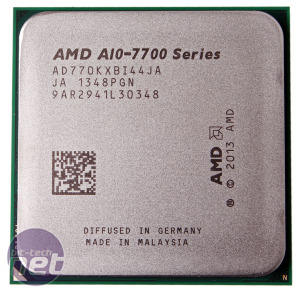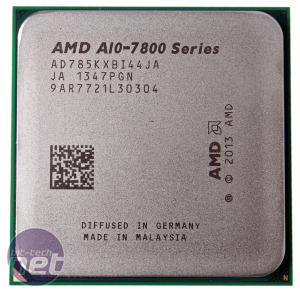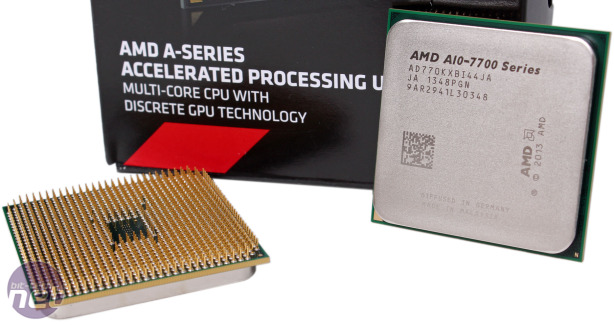
Performance Analysis
In Cinebench, the A10-7850K performs almost identically to the A10-6800K (but it does have a lower TDP and clock speeds, so IPC has definitely improved). We've already commented on Kaveri's massive wPrime improvement, likely down to the heftier front end, and both chips show this again with a healthy lead over the Core i3-4330. The A10-7700K, however, has no advantage over the cheaper A8-7600 (it's worse in wPrime, in fact). On the other hand, it can easily be overclocked, and in this state it rockets ahead of the A8 chip.In our image editing test, Intel has an obvious lead. Again, the A10-7850K performs closely to the A10-6800K and the A10-7700K is similar to the A8-7600, but even with the fastest Kaveri chip overclocked to 4.4GHz it can't even keep up with the lowly and aging Core i3-2100. AMD has a better showing in the video encoding portion, though the A10-7850K is still outpaced by the Core i3-4130 and i3-4330 by 4 and 11 percent respectively.
Overclocked, both A10 Kaveri parts are able to surpass the Core i3-4330. Our multi-tasking test is again inexplicably much worse on Kaveri than Richland and Trinity. Our instinct is that this is an anomaly specific to our benchmark software, but it's still a worrying drop off in performance.
MuseMage is heavily GPU limited, and it's something that AMD and its onboard GCN architecture shines in. Here, even the A10-7700K is better than the older A10-6800K, while the fully enabled A10-7850K is 10 percent quicker than the older Richland part, and the Intel Core-i3 4330 is simply left in the dust. Due to its heavily parallel nature, we also run BasemarkCL on the GPU portion of chips, and we see a similar pattern as a result: the A10-7850K scores 73.632 compared to just 48.694 for the A10-6800K. In both MuseMage and BasemarkCL, the A10-7700K and A8-7600 are extremely close (remember, they have the exact same GPU specifications).
In LuxMark, the 95W 7700K again has little to no advantage over the 65W A8-7600. Meanwhile, Intel's Core-i3 4330 has the best CPU only score (even beating an A10-7850K at 4.4GHz), demonstrating that Intel is no slacker when it comes to support for OpenCL 1.2 or older. However, the A10-7850K's much more powerful GPU, which scores almost double that of the A10-6800K, gives it the lead overall. Perhaps unexpectedly, however, the A10-7700K isn't able to triumph over the Intel chip overall, despite again having a significantly quicker GPU.
At 1080p, Battlefield 4 is unplayable unless you're using 2,133MHz memory, and even then that's on the lowest possible detail settings and the framerates are still a little rocky – it takes a fully overclocked A10-7850K to maintain 30fps here, and that's only in single player (albeit at a very demanding section). Hopefully, Mantle will improve the situation here, but nevertheless both chips offer decent improvements over the A10-6800K and, as expected, are leagues ahead of Intel's HD Graphics 4600.
Even on the low detail preset, BioShock is unplayable with either Kaveri part at 1080p, although slotting in some 2,133MHz memory does change this, giving the A10-7700K and A10-7850K minimum results of 27fps and 29fps, which boosted to at least 30fps via overclocking. Moving to the very low preset, both chips hit minimums of 31fps at stock speeds, but there's no real benefit over the A10-6800K or A8-7600. However, simply switching to 2,133MHz memory here boosts the performance of the A10-7700K by 23 percent and the A10-7850K by a whopping 29 percent. This all tells us that the game at this detail setting is very limited by memory bandwidth when using 1,600MHz RAM.
Skyrim on ultra detail, even with 0x AA, is too much for any APU to handle, although the A10-7850K at least shows improvement over the A10-6800K. Moreover, at this high a detail setting, the game is limited by raw GPU power rather than bandwidth – switching to 2,133MHz memory isn't enough to change the minimum framerates for either APU. Only with the combination of a higher GPU clock speed and faster memory do we see gains, especially on the A10-7850K. Dropping to high detail (again with 0x AA), the A10-7850K maintains its lead on the A10-6800K and is just about playable. 2,133MHz memory also has an impact here, but again only when the chips are also overclocked are they able to stay at or above 30fps.
Idle power consumption is a little high, especially compared to Intel, but under load we do see improvements, as the A10-7850K consumes 20W less than the A10-6800K, while matching or beating its scores in most benchmarks. Despite a 30W difference in TDP rating, the A8-7600 and A10-7700K have almost identical power consumption.

MSI MPG Velox 100R Chassis Review
October 14 2021 | 15:04











Want to comment? Please log in.